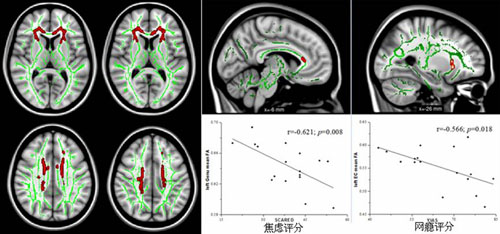
作为一种严重影响青少年身心健康的疾病,网瘾正越来越受到社会公众和研究人员的重视。近日,中国科学院武汉物理与数学研究所雷皓小组的一项最新研究进展表明,青少年网瘾的神经机制之一是大脑执行与控制功能的损伤。相关论文已被国际期刊《公共科学图书馆·综合》(PLoS One)接收,并进行了专文推介。
该研究是在国家自然科学基金和科技部“973”计划的支持下,由雷皓小组与上海交大仁济医院、上海精神卫生中心共同合作完成。
研究人员利用磁共振成像方法研究了青少年网瘾患者脑结构的改变,并运用基于纤维束的空间统计方法对青少年网瘾患者的脑扩散张量图像进行了分析。研究发现网瘾患者大脑中一些白质纤维束(包括胼胝体、外囊、内囊、辐射冠、扣带等区域)的微观结构出现损伤。
更重要的是,研究人员发现网瘾患者左侧胼胝体膝部损伤程度与其焦虑程度显著相关。此外,网瘾患者内囊、外囊白质损伤的模式与鸦片依赖患者非常类似,且左侧外囊损伤程度与患者网瘾严重程度显著相关。
据介绍,研究人员还运用基于体素的形态学方法分析了青少年网瘾患者大脑灰质体积的变化,发现其左侧舌回、后扣带皮质、前丘脑、左侧岛叶和前扣带皮质等区域存在显著萎缩。
以上结果显示,青少年网瘾患者的大脑灰质、白质均出现了结构性改变,且这种改变主要偏向于负责逻辑理解、判断、推理的左侧半脑。这些研究成果为青少年网瘾的临床诊断和治疗提供了重要的理论依据。
雷皓告诉《中国科学报》,物质依赖、成瘾的形成与神经可塑性改变密切相关。青少年时期是大脑控制与执行功能发育的关键时期,研究青少年网瘾相关的脑结构与功能的可塑性改变对于深入认识该疾病的发病机制和探索治疗/康复方案具有重要意义。

Gray matter abnormalities in Internet addiction: A voxel-based morphometry study
Yan Zhou, Fu-chun Lin, Ya-song Du, Ling-di Qin, Zhi-min Zhao, Jian-rong Xu, Hao Lei
Background This study aims to investigate brain gray matter density (GMD) changes in adolescents with Internet addiction (IA) using voxel-based morphometry (VBM) analysis on high-resolution T1-weighted structural magnetic resonance images.
Methods Eighteen IA adolescents and 15 age- and gender-matched healthy controls took part in this study. High-resolution T1-weighted magnetic resonance imaging scans were performed on the two groups. VBM analysis was used to compare the GMD between the two groups.
Results Compared with healthy controls, IA adolescents had lower GMD in the left anterior cingulate cortex, left posterior cingulate cortex, left insula, and left lingual gyrus.
Conclusions Our findings suggested that brain structural changes were present in IA adolescents, and this finding may provide a new insight into the pathogenesis of IA.
文献链接:https://www.ejradiology.com/article/S0720-048X(09)00589-0/abstract








